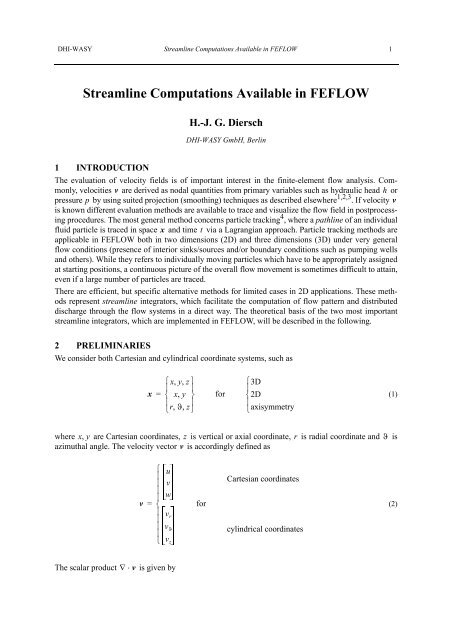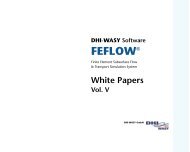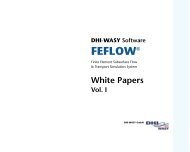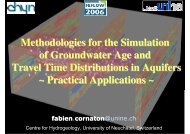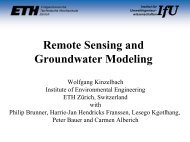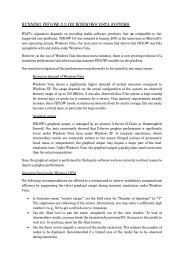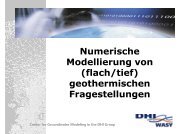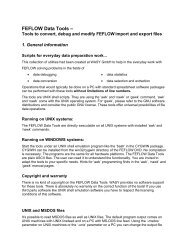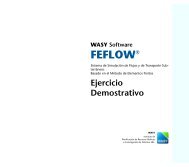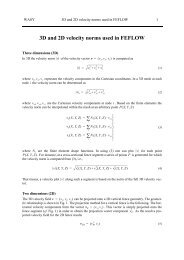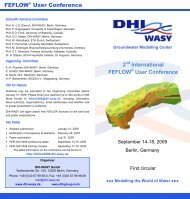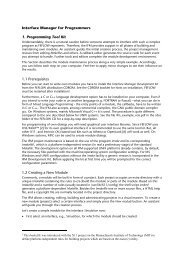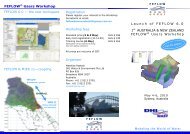Streamline Computation - FEFlow
Streamline Computation - FEFlow
Streamline Computation - FEFlow
Create successful ePaper yourself
Turn your PDF publications into a flip-book with our unique Google optimized e-Paper software.
DHI-WASY <strong>Streamline</strong> <strong>Computation</strong>s Available in FEFLOW 1<br />
<strong>Streamline</strong> <strong>Computation</strong>s Available in FEFLOW<br />
1 INTRODUCTION<br />
H.-J. G. Diersch<br />
DHI-WASY GmbH, Berlin<br />
The evaluation of velocity fields is of important interest in the finite-element flow analysis. Commonly,<br />
velocities are derived as nodal quantities from primary variables such as hydraulic head or<br />
pressure by using suited projection (smoothing) techniques as described elsewhere 1,2,3 . If velocity<br />
is known different evaluation methods are available to trace and visualize the flow field in postprocessing<br />
procedures. The most general method concerns particle tracking 4 v h<br />
p v<br />
, where a pathline of an individual<br />
fluid particle is traced in space x and time t via a Lagrangian approach. Particle tracking methods are<br />
applicable in FEFLOW both in two dimensions (2D) and three dimensions (3D) under very general<br />
flow conditions (presence of interior sinks/sources and/or boundary conditions such as pumping wells<br />
and others). While they refers to individually moving particles which have to be appropriately assigned<br />
at starting positions, a continuous picture of the overall flow movement is sometimes difficult to attain,<br />
even if a large number of particles are traced.<br />
There are efficient, but specific alternative methods for limited cases in 2D applications. These methods<br />
represent streamline integrators, which facilitate the computation of flow pattern and distributed<br />
discharge through the flow systems in a direct way. The theoretical basis of the two most important<br />
streamline integrators, which are implemented in FEFLOW, will be described in the following.<br />
2 PRELIMINARIES<br />
We consider both Cartesian and cylindrical coordinate systems, such as<br />
where x, y are Cartesian coordinates, z is vertical or axial coordinate, r is radial coordinate and ϑ is<br />
azimuthal angle. The velocity vector v is accordingly defined as<br />
The scalar product ∇ ⋅<br />
v is given by<br />
v<br />
x<br />
⎧x, y, z⎫<br />
⎪ ⎪<br />
= ⎨ x, y ⎬ for<br />
⎪ ⎪<br />
⎩r, ϑ, z⎭<br />
⎧<br />
⎪<br />
⎪<br />
⎪<br />
⎪<br />
u<br />
v<br />
w<br />
= ⎨ for<br />
⎪<br />
⎪<br />
⎪<br />
⎪<br />
⎩<br />
v r<br />
v ϑ<br />
v z<br />
⎧3D<br />
⎪<br />
⎨2D<br />
⎪<br />
⎩axisymmetry<br />
Cartesian coordinates<br />
cylindrical coordinates<br />
(1)<br />
(2)
DHI-WASY <strong>Streamline</strong> <strong>Computation</strong>s Available in FEFLOW 2<br />
( ∇ ⋅ v)<br />
The vector cross-product ( ∇ × v)<br />
reads<br />
=<br />
( ∇ × v)<br />
∂u ∂v ∂w<br />
----- + ----- + ------<br />
∂x ∂y ∂z<br />
∂u ∂v<br />
----- + -----<br />
∂x ∂y<br />
1<br />
--<br />
r<br />
∂ rv ( r)<br />
1<br />
-------------- --<br />
∂r r<br />
∂v ⎧<br />
⎪<br />
⎪<br />
⎪<br />
⎨<br />
⎪<br />
⎪<br />
ϑ ∂vz ⎪ + ------- + ------<br />
⎩<br />
∂ϑ ∂z<br />
=<br />
⎧<br />
⎪<br />
⎪<br />
⎪<br />
⎪<br />
⎪<br />
⎪<br />
⎪<br />
⎪<br />
⎪<br />
⎪<br />
⎪<br />
⎪<br />
⎨<br />
⎪<br />
⎪<br />
⎪<br />
⎪<br />
⎪<br />
⎪<br />
⎪<br />
⎪<br />
⎪<br />
⎪<br />
⎪<br />
⎪<br />
⎩<br />
∂w<br />
------<br />
∂y<br />
∂u<br />
-----<br />
∂z<br />
∂v<br />
– -----<br />
∂z<br />
∂w<br />
– ------<br />
∂x<br />
∂v ∂u<br />
----- – -----<br />
∂x ∂y<br />
∂v<br />
-----<br />
∂x<br />
3D (x, y, z) Cartesian<br />
2D (x, y) Cartesian<br />
cylindrical (r, ϑ, z)<br />
In other notation ( ∇ ⋅ v)<br />
is called the divergence of velocity vector v<br />
0<br />
0<br />
∂u<br />
– -----<br />
∂y<br />
1<br />
--<br />
r<br />
∂vz ∂vϑ ------ – -------<br />
∂ϑ ∂z<br />
∂vz ∂vr ------ – ------<br />
∂r ∂z<br />
1<br />
--<br />
r<br />
∂ rv ( ϑ)<br />
1<br />
--------------- --<br />
∂r r<br />
∂vr – ------<br />
∂ϑ<br />
div v = ∇ ⋅ v<br />
3D (x, yz) , Cartesian<br />
2D (x, y) Cartesian<br />
cylindrical (r, ϑ, z)<br />
and ( ∇ × v)<br />
is called the curl of velocity vector v or the vorticity vector w<br />
w = curl v = ∇ × v<br />
From (4) is can be recognized that w in 3D represents a general vector field. Contrarily, in 2D and for<br />
axisymmetric situations if assuming that all dependencies with respect to the azimuthal direction ϑ<br />
vanish, i.e., vϑ = ∂⁄ ∂ϑ =<br />
0 , we find the following useful curl-relations<br />
(3)<br />
(4)<br />
(5)<br />
(6)
DHI-WASY <strong>Streamline</strong> <strong>Computation</strong>s Available in FEFLOW 3<br />
where ω represents the (scalar) vorticity function.<br />
3 STREAMLINES AND STREAMFUNCTION<br />
A streamline is the locus of points that are everywhere tangent to the instantaneous velocity vector v .<br />
If ds is an element of length along a streamline, and thus tangent to the local velocity vector, then the<br />
equation of a streamline is given by (Fig. 1)<br />
or, in 2D Cartesian coordinates<br />
⎧<br />
⎪<br />
∂v ∂u<br />
----- – -----<br />
⎪∂x<br />
∂y<br />
ω = w = ⎨<br />
⎪∂v<br />
z ∂vr ⎪------<br />
– ------<br />
∂r ∂z<br />
⎩<br />
Two streamlines cannot intersect except where v = 0 .<br />
ds<br />
ds × v = 0<br />
dx<br />
---u<br />
=<br />
2D (x, y) Cartesian<br />
axisymmetric (r, z)<br />
Since, by definition, no flow can cross a streamline it requires that the velocity vector field v have to<br />
be divergence-free (solenoidal)<br />
That means the flow is to be steady-state and no distributed sources and sinks can exist in the flow<br />
domain.<br />
An equation that would describe such streamlines in a 2D (and axisymmetric) flow may be written in<br />
the form<br />
dy----v<br />
Figure 1 Definition of a streamline.<br />
∇ ⋅ v = 0<br />
ψ =<br />
ψ( x, y)<br />
v<br />
ψ = const<br />
(7)<br />
(8)<br />
(9)<br />
(10)<br />
(11)
DHI-WASY <strong>Streamline</strong> <strong>Computation</strong>s Available in FEFLOW 4<br />
where ψ is called the streamfunction. When ψ is constant (11) describes a streamline. It must obey the<br />
general differential relation for the change in the streamfunction, dψ ,<br />
The following definition relates ψ and the velocity components<br />
for 2D and<br />
dψ<br />
for axisymmetric flow. The definitions (13) and (14) automatically satisfy the condition of free divergence<br />
(10) in using (3). Substituting (13) into (12) it gives<br />
A major characteristic of the streamfunction is that the difference in ψ between two streamlines is<br />
equal to the volume flow rate Q between those streamlines. Let us consider two streamlines with values<br />
and as shown in Fig. 2.<br />
ψ A<br />
ψ B<br />
The volume flow rate between the streamlines is<br />
n<br />
dy -dx<br />
v r<br />
v<br />
=<br />
∂ψ ∂ψ<br />
------dx + ------dy<br />
∂x ∂y<br />
∂ψ<br />
∂ψ<br />
u = ------ v = – ------<br />
∂y<br />
∂x<br />
1<br />
--<br />
r<br />
∂ψ<br />
1<br />
= ------ vz --<br />
∂z<br />
r<br />
∂ψ<br />
= – ------<br />
∂r<br />
dψ = – v dx + u dy<br />
ψ = ψ Β<br />
ψ = ψ Α<br />
Figure 2 Streamfunction in a plane flow.<br />
Q AB<br />
B<br />
dy<br />
= ∫v⋅n ds<br />
=<br />
∫(<br />
unx + vny) ds<br />
A<br />
B<br />
A<br />
ds<br />
n<br />
-dx<br />
n y<br />
n x<br />
(12)<br />
(13)<br />
(14)<br />
(15)<br />
(16)
DHI-WASY <strong>Streamline</strong> <strong>Computation</strong>s Available in FEFLOW 5<br />
where n is the normal unit vector. By geometry we have the relations nxds = dy and nyds = – dx<br />
.<br />
With these relations (16) becomes<br />
The flow rate between streamlines is the difference in their streamfunction values. This equation is also<br />
unaffected by the addition of an arbitrary constant to ψ .<br />
4 STREAMLINE INTEGRATOR BY USING VORTICITY EQUATION<br />
For 2D and axisymmetric flows a very efficient approach to computing the streamfunction distribution<br />
for a given velocity field is based on using the vorticity function ω . By substituting the streamfunction<br />
definition (13) into the vorticity equation (7) the following elliptic partial differential (Poisson) equation<br />
is obtained<br />
or<br />
∇ 2<br />
– ψ<br />
B<br />
∫<br />
QAB = ( udy – vdx)<br />
=<br />
A<br />
QAB = ψB – ψA ∇ 2 – ψ = ω<br />
Equation (19) can be easily solved by the finite element method if formulating an unique boundary<br />
value problem of the domain Ω enclosed by the boundary Γ . The Galerkin-based finite element formulation<br />
of (19) gives (exemplified for 2D Cartesian)<br />
∫<br />
Ω<br />
∇N∇N T ( dΩ)Y<br />
by introducing finite element interpolation functions for the streamfunction and velocity components<br />
where Y, U, V are nodal vectors and N are finite element shape functions. The boundary integral in<br />
(20) vanishes because the flux normal to the streamline direction is zero,<br />
n ⋅ ∇ψ<br />
∂ψ ∂ψ<br />
= nx------ + ny------ ∂x ∂y<br />
= – nxv + nyu = 0 if the velocity vector field v is divergence-free (solenoidal),<br />
i.e., ∇ ⋅ v =<br />
0 . Accordingly, the following linear matrix system results<br />
B<br />
∫<br />
A<br />
dψ<br />
⎧∂v<br />
∂u 2D (x, y) Cartesian<br />
⎪-----<br />
– -----<br />
⎪∂x<br />
∂y<br />
= ⎨<br />
⎪⎛∂vz∂vr<br />
------ – ------ ⎞raxisymmetric (r, z)<br />
⎪⎝<br />
∂r ∂z ⎠<br />
⎩<br />
=<br />
∫<br />
Ω<br />
∂N T<br />
---------V<br />
∂x<br />
∂NT<br />
⎛ – ---------U ⎞dΩ+ Nn ( ⋅ ∇ψ)<br />
⎝ ∂y ⎠ ∫ dΓ<br />
ψ N T = Y<br />
u N T = U<br />
v N T = V<br />
Γ<br />
(17)<br />
(18)<br />
(19)<br />
(20)<br />
(21)
DHI-WASY <strong>Streamline</strong> <strong>Computation</strong>s Available in FEFLOW 6<br />
A ⋅ Y = BUV ( , )<br />
for solving the streamfunction Y at each nodal point of a finite element mesh with known nodal velocity<br />
components U, V.<br />
The matrix A is symmetric and sparse. The equation system (22) is solved via<br />
standard matrix solvers. However, a suitable boundary condition for Y is required. Practically, at only<br />
one node on the outer boundary Γ the streamfunction is set to a Dirichlet-type reference value of zero.<br />
The solution (22) is restricted to a solenoidal 2D (or axisymmetric) velocity vector field v , i.e., steadystate<br />
flow, no interior boundary conditions (e.g., fluxes, wells) and absence of sinks and sources.<br />
5 STREAMLINE INTEGRATOR BY USING BOUNDARY INTEGRAL<br />
This streamline integration method is based on the numerically solution of differential (16) written in<br />
the form<br />
B<br />
∫<br />
δψ = ( unx + vny) ds<br />
A<br />
where δψ is the change in the streamfunction which is to be solved along a defined boundary. In the<br />
preferred method the computation of δψ is carried out using (23) along each boundary of finite elements,<br />
where the integration path AB is taken as element edge. We consider a typical element boundary<br />
as shown in Fig. 3. The following finite element interpolations are introduced<br />
u N T = U<br />
v N T = V<br />
x N T = X<br />
y N T = Y<br />
where N are finite element shape functions and U, V, X, Y are vectors of nodal point velocities and<br />
coordinates.<br />
y<br />
global coordinates coordinate transformation local coordinates<br />
x<br />
Figure 3 Definition of element boundary for streamfunction computation.<br />
In the finite element standard procedure the global coordinates ( x, y)<br />
in 2D are transformed to local<br />
coordinates ( ξ, η)<br />
(Fig. 3). For a infinitesimal line element ds it results<br />
ds<br />
written for the local coordinate ( – 1 ≤ξ≤1) at element boundaries where η<br />
sponds to the length of the boundary segment. Using (25) we find<br />
= ± 1 . In (25) L<br />
corre-<br />
η<br />
(-1,1) (1,1)<br />
(-1,-1) (1,-1)<br />
⎛∂x ----- ⎞<br />
⎝∂ξ⎠ 2<br />
⎛∂y ----- ⎞<br />
⎝∂ξ⎠ 2<br />
= + dξ = L dξ<br />
ξ<br />
element edge<br />
(-1) n<br />
(+1)<br />
ξ<br />
(22)<br />
(23)<br />
(24)<br />
(25)
DHI-WASY <strong>Streamline</strong> <strong>Computation</strong>s Available in FEFLOW 7<br />
and their inverse<br />
∂s<br />
----- L<br />
∂x<br />
∂ξ<br />
= -----<br />
∂x<br />
∂x<br />
-----<br />
∂s<br />
1<br />
--<br />
L<br />
∂x<br />
-----<br />
∂ξ<br />
Using (27) the unit normal vector can be expressed by<br />
n<br />
=<br />
∂s<br />
----- L<br />
∂y<br />
∂ξ<br />
= -----<br />
∂y<br />
Combining (25) and (28) with (23) the streamline integral along any finite element boundary takes the<br />
form<br />
δψ<br />
=<br />
where the coordinate interpolation functions (24) are applied.<br />
The change in the streamfunction along any element edges is computed from (29) with known nodal<br />
velocity vectors U, V.<br />
The computation of the streamfunction for an entire finite element mesh is generated<br />
by applying (29) along successive element boundaries, starting at a node for which a reference<br />
value of ψ<br />
has been specified. Unlike the vorticity integration method the present boundary integral<br />
method is only an element-by-element procedure, which is computationally efficient and does not<br />
require the solution of a matrix problem. However, the boundary integrator is also limited to solenoidal<br />
velocity fields, i.e, steady-state flow, no interior boundary conditions (e.g., fluxes, wells) and absence<br />
of sinks and sources.<br />
6 CONCLUSIONS<br />
FEFLOW provides two streamline integration methods (vorticity equation integrator and boundary<br />
integral method) as additional tools to evaluate velocity fields in an alternative way in contrast to particle<br />
tracking techniques. However, these streamline integrators are limited to steady-state 2D (or axisymmetric)<br />
flow problems, where neither interior boundary conditions (such as fluxes or pumping<br />
wells) nor sinks and sources should exist. While the boundary integral method does not require the<br />
solution of a matrix problem, the vorticity equation integrator produces often more accurate results and<br />
has shown more robust. Accordingly, the vorticity equation integrator represents the method of our<br />
first choice. <strong>Streamline</strong> integrators are very useful for instance in density-variable flow simulations<br />
(see 2D streamline patterns as shown in the references 1,2,3 ), where complex recirculating flow patterns<br />
(eddies) can occur, which cannot be easily detected and visualized by using particle tracking methods.<br />
In such cases, although the density-coupled mass (or heat) transport process is transient, the flow field<br />
is divergence-free at each time step (FEFLOW runs in the so-called steady flow-transient transport<br />
time mode) because the absence of storage (by fluid and skeleton compression) in the flow problem<br />
assuming no interior boundary conditions and sinks/sources.<br />
∂y<br />
-----<br />
∂s<br />
∂y<br />
n<br />
----x<br />
= =<br />
∂s<br />
=<br />
ny ∂x<br />
– -----<br />
∂s<br />
+1<br />
∫<br />
– 1<br />
∂N T<br />
=<br />
1<br />
--<br />
L<br />
1<br />
--<br />
L<br />
∂y<br />
-----<br />
∂ξ<br />
∂y<br />
-----<br />
∂ξ<br />
∂x<br />
– -----<br />
∂ξ<br />
---------Y N<br />
∂ξ<br />
T U ∂NT<br />
---------X N<br />
∂ξ<br />
T ⎛ – V⎞dξ<br />
⎝ ⎠<br />
(26)<br />
(27)<br />
(28)<br />
(29)
DHI-WASY <strong>Streamline</strong> <strong>Computation</strong>s Available in FEFLOW 8<br />
7 REFERENCES<br />
1. Diersch, H.-J.G., Consistent velocity approximation in the finite-element simulation of density-dependent<br />
mass and heat transport processes. FEFLOW’s White Papers Vol. I, Chapter 16, WASY GmbH, Berlin,<br />
2002.<br />
2. Diersch, H.-J.G., Coupled groundwater flow and transport: thermohaline and 3D convection systems.<br />
FEFLOW’s White Papers Vol. I, Chapter 17, WASY GmbH, Berlin, 2002.<br />
3. Diersch, H.-J.G., Variable-density flow and transport in porous media: approaches and challenges.<br />
FEFLOW’s White Papers Vol. II, Chapter 1, WASY GmbH, Berlin, 2005.<br />
4. Zheng, C. and Bennett, G.D. Applied contaminant transport modeling. Van Nostrand Reinhold, New York,<br />
1995.


